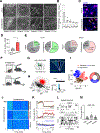Reviving-like prosocial behavior in response to unconscious or dead conspecifics in rodents
- PMID: 39977514
- PMCID: PMC12011203
- DOI: 10.1126/science.adq2677
Reviving-like prosocial behavior in response to unconscious or dead conspecifics in rodents
Abstract
Whereas humans exhibit emergency responses to assist unconscious individuals, how nonhuman animals react to unresponsive conspecifics is less well understood. We report that mice exhibit stereotypic behaviors toward unconscious or dead social partners, which escalate from sniffing and grooming to more forceful actions such as mouth or tongue biting and tongue pulling. The latter intense actions, more prominent in familiar pairs, begin after prolonged immobility and unresponsiveness and cease when the partner regains activity. Their consequences, including improved airway opening and clearance and accelerated recovery from unconsciousness, suggest rescue-like efforts. Oxytocin neurons in the hypothalamic paraventricular nucleus respond differentially to the presence of unconscious versus active partners, and their activation, along with oxytocin signaling, is required for the reviving-like actions. This tendency to assist unresponsive members may enhance group cohesion and survival of social species.
Conflict of interest statement
Figures







Comment in
-
An innate drive to save a life.Science. 2025 Feb 21;387(6736):827-828. doi: 10.1126/science.adv3731. Epub 2025 Feb 20. Science. 2025. PMID: 39977520
References
-
- De Marco A, Cozzolino R, Thierry B, Coping with mortality: responses of monkeys and great apes to collapsed, inanimate and dead conspecifics. Ethology Ecology & Evolution 34, 1–50 (2022).
MeSH terms
Substances
Grants and funding
LinkOut - more resources
Full Text Sources
Molecular Biology Databases

